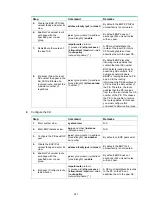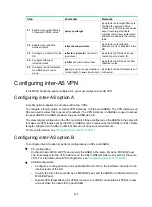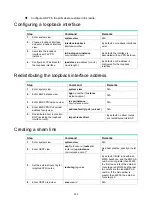
228
Step Command
Remarks
11.
(Optional.) Configure the PE
to not change the next hop of
routes advertised to the
EBGP peer.
peer
{
group-name
|
ipv4-address
[
mask-length
] }
next-hop-invariable
By default, the device uses its
address as the next hop of routes
advertised to peers.
Configure this command on the
RR so the RR does not change
the next hop of advertised VPNv4
routes.
Configuring an ASBR
To set up an inter-AS public tunnel for the inter-AS option C solution, an ASBR must assign an MPLS
label to the route destined for a PE, and advertise the label along with the route. Typically, the routes
advertised by an ASBR through BGP include the PE address as well as other routes. You can
configure a routing policy to filter routes. Routes surviving the filtering are assigned labels, and all
others are advertised as common IPv4 routes.
To configure a routing policy, use the following commands:
•
if-match
mpls-label
—Matches routes carrying MPLS labels.
•
apply
mpls-label
—Sets MPLS labels for IPv4 routes advertised to a peer. You can use this
command together with
if-match
clauses. For example, the
apply mpls-label
command works
together with the
if-match mpls-label
command to set new MPLS labels for routes with MPLS
labels. The newly assigned labels are advertised along with the routes.
For more information about routing policy configuration, see
Layer 3—IP Routing Configuration
Guide
.
To configure an ASBR for inter-AS option C:
Step Command
Remarks
1.
Enter system view.
system-view
N/A
2.
(Optional.) Create a routing
policy, and enter routing
policy view.
route-policy
route-policy-name
{
deny
|
permit
}
node
node-number
By default, no routing policies
exist.
3.
(Optional.) Match IPv4
routes carrying labels.
if-match mpls-label
By default, no MPLS label match
criterion is configured.
4.
(Optional.) Set labels for
IPv4 routes.
apply mpls-label
By default, no MPLS label is set
for IPv4 routes.
5.
Return to system view.
quit
N/A
6.
Enter interface view of the
interface connected to an
internal router of the AS.
interface
interface-type
interface-number
N/A
7.
Enable MPLS on the
interface.
mpls enable
By default, MPLS is disabled on
the interface.
8.
Enable MPLS LDP on the
interface.
mpls ldp enable
By default, MPLS LDP is disabled
on the interface.
9.
Return to system view.
quit
N/A
10.
Enter interface view of the
interface connected to the
remote ASBR.
interface
interface-type
interface-number
N/A
11.
Enable MPLS on the
interface.
mpls enable
By default, MPLS is disabled on
the interface.
12.
Return to system view.
quit
N/A






























